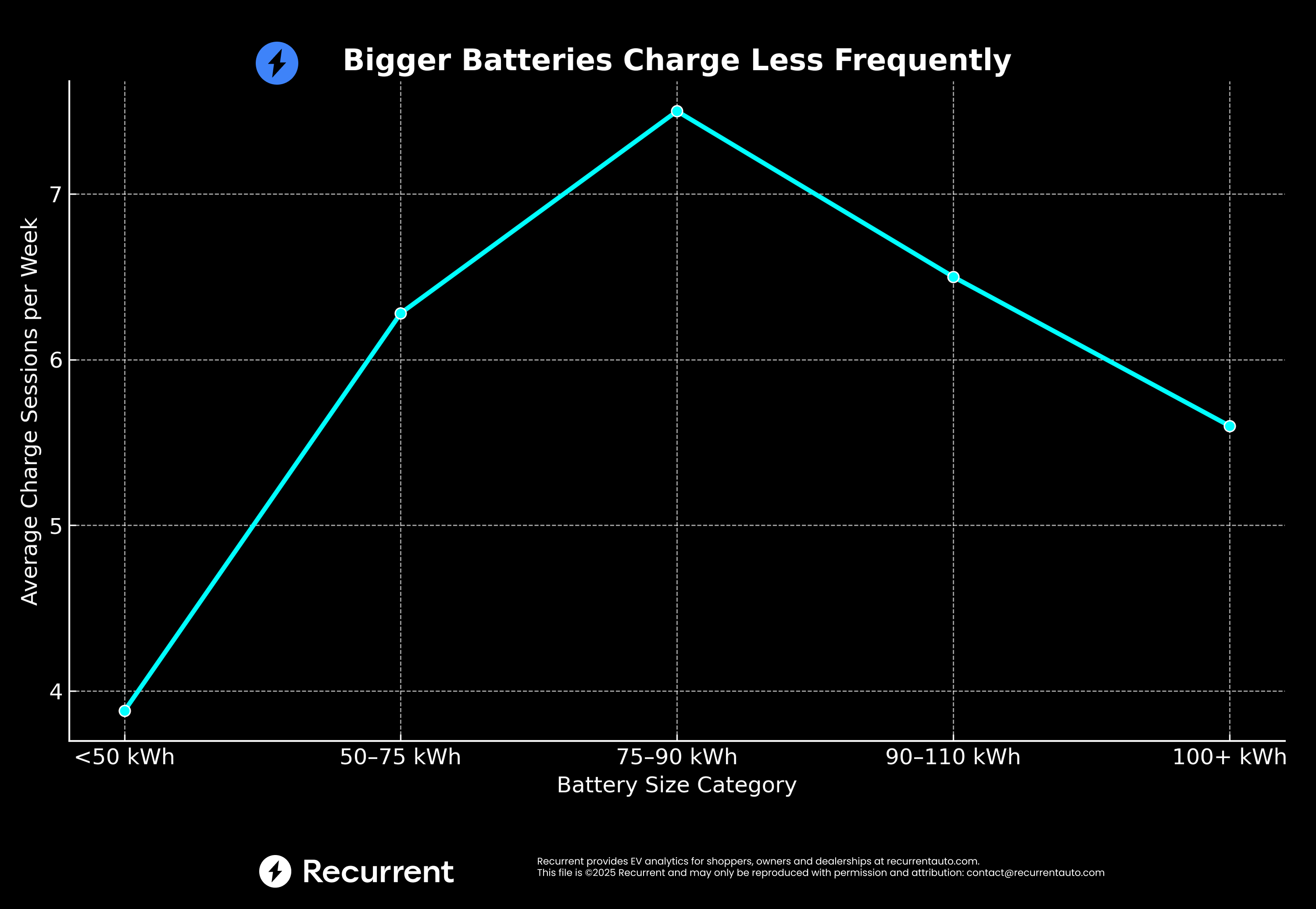Our latest analysis shows that larger battery EVs aren't just about longer range — in fact, we found that average daily mileage only varies by about 10 miles, regardless of a car’s range or battery size. But, larger batteries change how frequently you need to plug in and how much you add per session.
Bigger Batteries Add More Miles Per Charge
We looked at charging patterns across thousands of EVs grouped by battery size. Across all sizes, drivers tend to start charging around 54–57% SOC. It makes sense that people with smaller batteries might get nervous and decide to plug in sooner than people with more range.
But as the battery size increases, each percentage point of added charge holds more energy and more range. For instance, 5% of 100 is 5, whereas 5% of 50 is only 2.5. It works the same with battery sizes.
.png)
For example, if you drive a Nissan LEAF with a 40 kWh battery, you’re likely to start a charging session around 57% and stop near 86%, which gives you about 43 miles of usable range. Meanwhile, a Hyundai Ioniq 5 RWD, with a battery around 63 kWh, adds nearly 20 more miles per charge under similar charging behavior.
In contrast, those with large-battery vehicles like the Hummer EV or Cadillac Lyriq get significantly more range per charge and can go longer between sessions. These cars cost more, but if you don’t have access to reliable home charging, the price may be worth it.
Bottom line? 💡 Bigger batteries don’t just give you more range — they might give you your time back.
Bigger Batteries Charge Less Frequently
In addition to larger batteries storing more energy per percent, we noticed that they had fewer charge sessions per week.

<50 kWh: 3.88 average charges/week
50–75 kWh: 6.28 average charges/week
75–90 kWh: 7.5 average charges/week
90–110 kWh: 6.5 average charges/week
100+ kWh: 5.6 average charges/week
Interestingly, the smallest battery group (<50 kWh) has fewer weekly charges than mid-sized packs (50–90 kWh). This may be because owners of small-battery EVs may limit mileage or rely on a second car. But once battery sizes hit the 90 –110 kWh range and beyond, the benefit becomes clear: you gain more usable range per session and charge less frequently overall.
In short:
🔌 Smaller batteries = more frequent charging for fewer miles
🔋 Bigger batteries = fewer sessions with more range added each time
Why This Matters If You Can’t Charge At Home
A bigger battery gives you more usable miles per plug-in, which translates to fewer detours, less planning, and more freedom. In that sense, the added cost of a larger battery isn’t just about range anxiety — it’s a quality-of-life improvement.
If you’re able to plug in every night at home, like most EV drivers in the US today, this difference may not seem like a big deal. But if you rely on public charging or live in a multi-unit building where outlets are limited, every charging session matters. As more city dwellers and younger people become interested in EVs, this becomes a factor to consider.
The Catch: Cost
Of course, bigger batteries aren’t without tradeoffs. In addition to adding weight to the vehicle, generally reducing efficiency (e.g. Hummer EV), they also add significant cost to the purchase price. Since the battery is the most expensive part of an EV, getting a bigger one is an investment. This is especially true since most of us don’t need 300+ miles of range, and lower vehicle efficiency means higher energy costs to recharge. But for drivers who have more money than time, the value of charging less often might be worth the premium.
Final Thought
When evaluating an EV, don’t just ask how far it can go, ask how often you’ll need to charge (and how fast that will happen!). Bigger batteries change that equation. And if you don’t have easy home charging, that difference could dramatically shape your experience.

-p-500.png)
.png)


